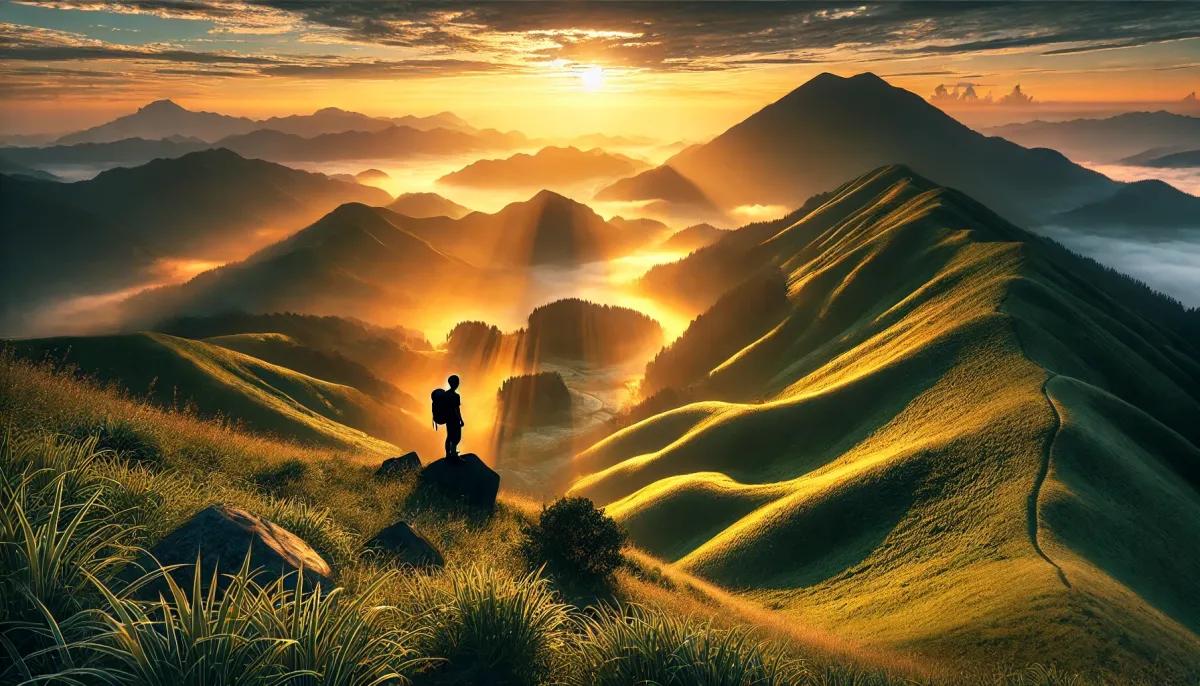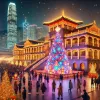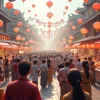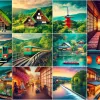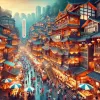Hey everyone, Mark here, your friendly neighborhood American backpacker! I’ve been exploring Asia’s incredible cities and hidden gems for years, and this time, I set my sights on Mount Wugong in Jiangxi province, China. This wasn't just a mountain climb; it was a journey into the heart of China, experiencing its high-speed rail and breathtaking landscapes. So, is it worth the trip? Let's dive in!
My High-Speed Rail Adventure: From Changsha to Pingxiang
I’m a huge fan of efficient travel, and China's high-speed rail system is truly something special. It's the world's largest high-speed rail network, boasting over 40,000 kilometers of operational lines, with trains reaching speeds of up to 350 kilometers per hour! That's some serious speed!
I took the Fuxing Hao (復興號), a domestically developed high-speed train. The second-class seat cost a mere 4 RMB (around $0.55 USD) for my ride to Pingxiang North Station. The station itself was a surprise – more like a massive shopping mall than just a transit hub! I grabbed some local snacks like small bowl steamed vegetables and braised fish (a delicious 29 RMB meal!). They even had a whole floor dedicated to regional specialties from Changsha, including stinky tofu (28 RMB) and a sauce-marinated duck (50 RMB) – a taste of Hunan I couldn't resist! Boarding was efficient and seamless, all done with my ID card – no paper tickets needed.
| Item | Price (RMB) | Price (USD approx) | Notes |
|---|---|---|---|
| Second-class train ticket | 4 | $0.55 | Pingxiang North Station |
| Small bowl steamed veg | Varied | Varied | Variety available |
| Braised fish | 29 | $4.00 | A flavorful dish |
| Stinky tofu | 28 | $3.90 | A Changsha specialty |
| Sauce-marinated duck | 50 | $6.90 | A regional Hunan delight |
| Bus to Mount Wugong | 27 | $3.70 | From Pingxiang North Station |
Reaching Mount Wugong: A Journey into the Heart of Jiangxi
From Pingxiang North Station, getting to Mount Wugong was straightforward. I hopped on a bus (27 RMB) directly to the mountain. The entire town seemed focused on Mount Wugong; it reminded me of being in Emei, Sichuan, where everything revolves around Mount Emei. The bus ride gave me a glimpse into the local life, filled with anticipation for the mountain adventure ahead. The bus ride itself was about an hour, with a brief 5-minute stop in Xinquan Township, where I grabbed some overpriced instant noodles (10 RMB, market price is 8 RMB) and a raincoat (10 RMB) – a smart move considering Mount Wugong's reputation for rain, especially during night climbs.
Mount Wugong: A National 5A Scenic Area
Mount Wugong, part of the Luo Xiao mountain range, boasts the impressive Baihe Peak, reaching 1,918 meters (6,293 feet) – one of Jiangxi's highest peaks. Designated a National 5A scenic area in 2020, its claim to fame? Vast alpine meadows, a rare sight in Southern China. It’s these stunning landscapes that drew me, and many other young travelers, to this captivating destination.
I spoke to a local villager about the current state of tourism. While the mountain's popularity remains, the villager mentioned that business isn't as booming as it once was, citing economic challenges and a shift in visitor demographics – more students, fewer high-spending tourists. This made me realize the impact of global economic trends even in remote areas like this.
Accommodation & Local Life: Beyond the Tourist Trail
I stayed in a local's homestay for an affordable and authentic experience. The homestay cost much less than the hotels in town, offering comparable comfort and convenience with the bonus of easy access to delicious, affordable local cuisine. The family also ran a small restaurant, offering traditional home-cooked meals for reasonable prices (a three-fresh soup noodle costing just 15 RMB). Seeing their comfortable home and car (possibly a Mercedes, if my eyes weren't deceiving me) highlighted the multiple income streams that tourism can generate for local communities. This homestay experience provided valuable insights into the lives of the people who call this area home.
The Night Climb and the Chase for Sunrise
Many young people opt for night climbs to witness the sunrise from the mountaintop – a spectacular sight perfect for social media. Following local advice, I planned my ascent accordingly. The starting point was the Wugongshan Tourist Service Center.
I took a free shuttle bus to the cable car station, encountering several disappointed night climbers on the way – a reminder that Mother Nature doesn't always cooperate with our plans. The ride was short, and soon I was at Shigusi (石鼓寺), the lower cable car station.
Ascending to the Summit: Cable Cars and Hiking
My right knee was acting up, so I opted for a cable car ride to Zhong'an (中庵) to reduce strain. After enjoying a filling breakfast (8 RMB for a bowl of mixed noodles, 10 RMB for 8 steamed dumplings), I began the final ascent to the summit. The cable car ride itself was uneventful, a rather common experience by international standards. I exchanged some currency at the Zhong'an cable car station, noticing a dedicated foreign exchange window – further evidence of international tourism here.
A Challenging Ascent Through the Clouds
The higher I climbed, the more dramatic the weather became. The winds were intense, even colder than air conditioning, and the visibility fluctuated wildly due to the dense fog. There was even free ginger tea available near the Zhong'an cable car station, a much-needed comfort as I battled the cold. The views were spectacular when the fog cleared, revealing stunning mountain vistas. The entire hike challenged my physical and mental limits, and though I considered giving up at several points, the rewarding views and sense of accomplishment made it worthwhile.
The Summit and the Descent: A Journey of Perseverance
The path to the summit was steep and winding, passing through scenic spots such as the Zi Ji Gong (紫極宮), the Xing Kong Zhan Dao (星空棧道), and the Fu Xing Gu (福星谷). The climb was challenging, with varying degrees of difficulty and spectacular views in between. Along the way, I enjoyed moments of stunning beauty and challenging climbs, with the rewards well worth the effort. I reached the summit, albeit later than expected due to frequent stops for photography, around 11:20 AM, completing a three-hour climb.
Despite the breathtaking views at the summit, the weather conditions were challenging. Even the high-altitude wind was bitterly cold, and the fog significantly reduced visibility. While the summit itself provided a sense of accomplishment, the journey was filled with both beautiful moments and physical and mental challenges.
The descent was just as thrilling, with the cable car providing a welcome respite after the strenuous climb. The aerial views were spectacular, allowing me to appreciate the vastness and beauty of Mount Wugong from a different perspective.
Final Thoughts: Is Mount Wugong Worth It?
Absolutely! Mount Wugong offers a unique blend of natural beauty, cultural experiences, and modern conveniences. The high-speed rail system made traveling there exceptionally easy, and the local hospitality was warm and welcoming. The night climb and sunrise views, while weather-dependent, offer a truly unforgettable experience.
The challenges I faced – the steep inclines, the unpredictable weather, and my own physical limitations – reminded me of the importance of persistence and self-belief. The rewards of reaching the summit and witnessing the breathtaking scenery were well worth the effort.
